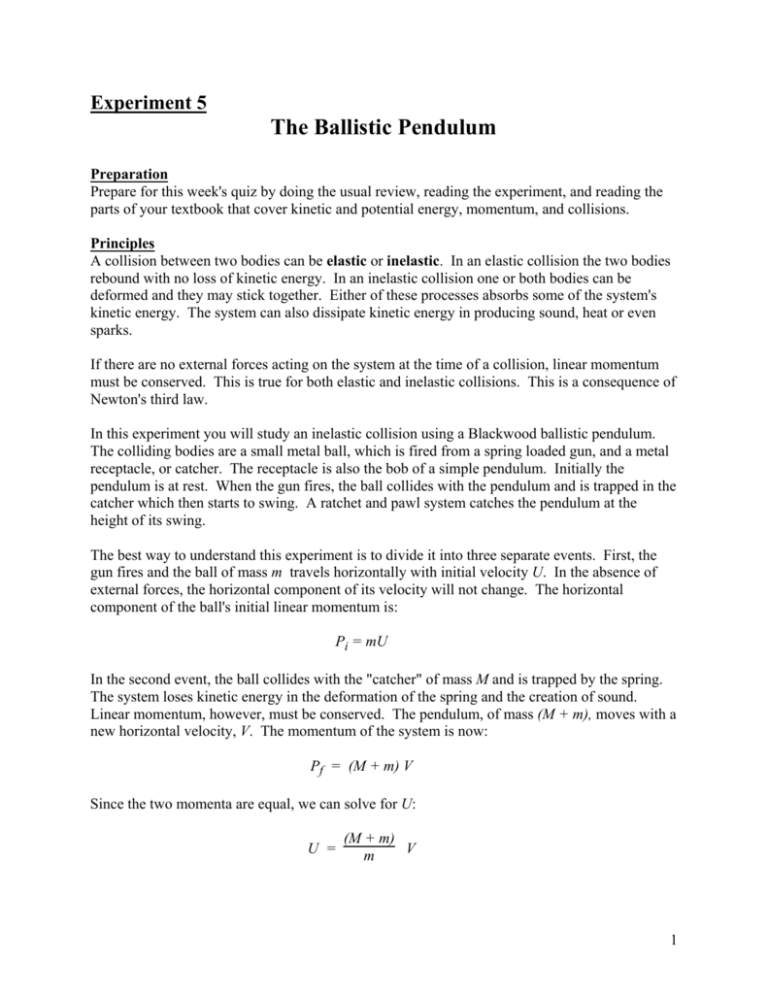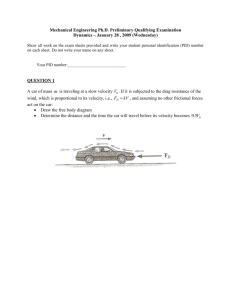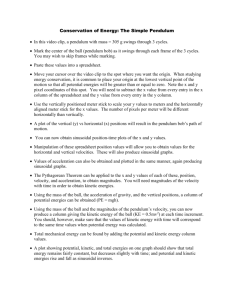Experiment 5 The Ballistic Pendulum
advertisement

Experiment 5 The Ballistic Pendulum Preparation Prepare for this week's quiz by doing the usual review, reading the experiment, and reading the parts of your textbook that cover kinetic and potential energy, momentum, and collisions. Principles A collision between two bodies can be elastic or inelastic. In an elastic collision the two bodies rebound with no loss of kinetic energy. In an inelastic collision one or both bodies can be deformed and they may stick together. Either of these processes absorbs some of the system's kinetic energy. The system can also dissipate kinetic energy in producing sound, heat or even sparks. If there are no external forces acting on the system at the time of a collision, linear momentum must be conserved. This is true for both elastic and inelastic collisions. This is a consequence of Newton's third law. In this experiment you will study an inelastic collision using a Blackwood ballistic pendulum. The colliding bodies are a small metal ball, which is fired from a spring loaded gun, and a metal receptacle, or catcher. The receptacle is also the bob of a simple pendulum. Initially the pendulum is at rest. When the gun fires, the ball collides with the pendulum and is trapped in the catcher which then starts to swing. A ratchet and pawl system catches the pendulum at the height of its swing. The best way to understand this experiment is to divide it into three separate events. First, the gun fires and the ball of mass m travels horizontally with initial velocity U. In the absence of external forces, the horizontal component of its velocity will not change. The horizontal component of the ball's initial linear momentum is: Pi = mU In the second event, the ball collides with the "catcher" of mass M and is trapped by the spring. The system loses kinetic energy in the deformation of the spring and the creation of sound. Linear momentum, however, must be conserved. The pendulum, of mass (M + m), moves with a new horizontal velocity, V. The momentum of the system is now: Pf = (M + m) V Since the two momenta are equal, we can solve for U: U = (M + m) V m 1 Finally, the system acts like a simple pendulum. It moves upward and is caught by the ratchet at the highest part of its swing. The ratchet and pawl are designed to exert negligible force on the pendulum while it is moving upward, so mechanical energy is conserved. This means that the pendulum's kinetic energy at the bottom of its swing must equal its potential energy at the top of its swing. The change in height, h, of the center of mass can be easily measured. We can then solve for V: (M + m) 2 V = (M + m) gh 2 Therefore: V = 2gh Substitute this value for V into the equation for U: U = (M + m) 2gh m There is a different, more direct way to measure the initial velocity of the ball. We can fire the gun horizontally from a known height and measure how far it travels before it hits the ground. Call this the range of the ball, R. The velocity, U, is given by: R U=T where T is the time of flight. We can solve for the time of flight because the ball's horizontal and vertical motion are independent. As it moves horizontally, the ball also falls because of the influence of gravity. If the ball drops a distance Y: 1 Y = 2 g T2 T= 2Y g solve for U: U=R g 2Y Equipment 1 Blackwood ballistic pendulum with catcher and ball 1 pan balance 1 meter stick 2 two meter sticks 1 piece of aluminum foil masking tape 2 Procedure Use SI units. Measure masses to 0.001 kg. Measure lengths to 0.001 m. For your calculations use g = 9.80 m/sec2. Your instructor will show you how to load and fire the gun. It is important that the catcher be correctly aligned with the gun. When you fire, pull the trigger gently and don’t jerk the apparatus. Occasionally the ball will miss the catcher; therefore do not fire it if anyone is within range of the ball. If your catcher is the type that uses a spring, be careful when you remove the ball from the catcher; push the spring inward to release the ball. The spring will break if you pull it backwards. Method I 1. Unscrew the set screw that holds the pendulum at the top of the apparatus. Measure the mass of the ball (m) and of the ball and pendulum together (M + m). Reassemble the apparatus. Make sure that the pendulum can swing freely with a minimum of side-to-side motion. 2. Fire the gun and record the number of the notch in which the pendulum comes to rest. Repeat twice. If the notch numbers vary greatly take some more data. If the results are wildly inconsistent, or if you have other problems, consult your instructor. 3. While the pendulum is hanging freely, measure the height of the center of mass marker from the base of the apparatus. 4. Average the notch numbers and raise the pendulum to that notch. Measure the height of the center of mass marker from the base of the apparatus. The difference between the two heights is h. 5. Use U = (M + m) 2gh to find the initial velocity of the ball. m 3 Method II 6. Leave the pendulum raised. Position the apparatus near the end of the table so that it is aimed out across the floor with a range of about three meters. Shoot the ball and note where it hits the floor. Make sure that the gun does not move. Use masking tape to secure a piece of foil to the floor where the ball landed. Fire the ball three more times or until you have three marks on the foil. 7. Measure the horizontal distance from the point on the floor directly below the ball to the center of the marks on the carbon set. This distance is R. 8. Put the ball back on the gun rod but do not cock it. Measure the distance from the bottom of the ball to the floor. This is Y. Y is easier to measure if you move the whole apparatus to the edge of the table. 9. Use U = R g 2Y to find U. Find the percent difference between the two values of U that you found. 10. Be sure the catcher is attached to the ballistic pendulum when you put the equipment 4









